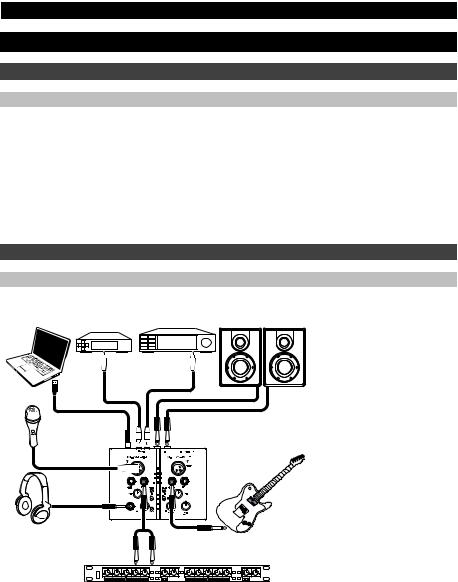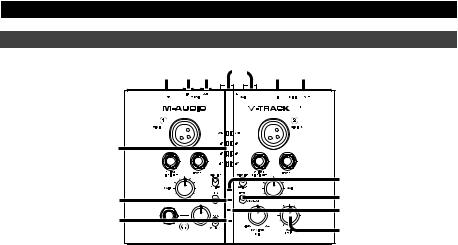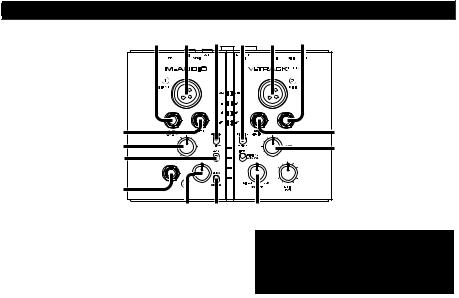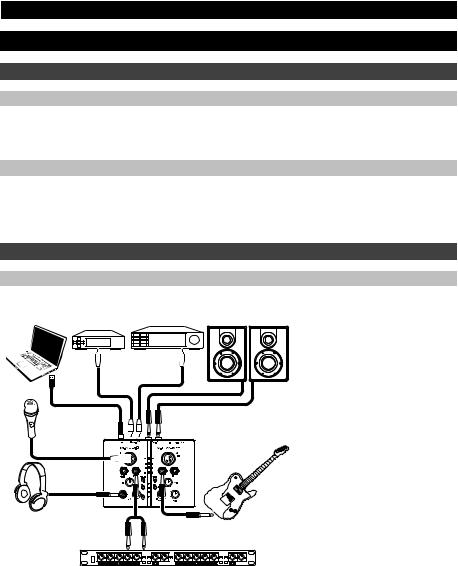M-audio M-Track Plus User Manual [ru]

User Guide
English ( 3 – 6 )
Guía del usuario
Español ( 7 – 10 )
Guide d'utilisation
Français ( 11 – 14 )
Guida per l'uso
Italiano ( 15 – 18 )
Benutzerhandbuch
Deutsch ( 19 – 22 )
Appendix
English ( 23 )

User Guide (English)
Introduction
Box Contents
M-Track Plus |
User Guide |
USB Cable |
Safety & Warranty Manual |
|
|
Support |
|
For the latest information about this product (system requirements, compatibility information, etc.) and product registration, visit m-audio.com.
For additional product support, visit m-audio.com/support.
Quick Start
Setup Scenario*
Computer |
Digital |
Stereo System |
Monitors |
|
Cable Box** |
Receiver*** |
|||
|
|
|||
|
|
STEREO 1 |
|
|
|
284 |
VOL: 28 |
|
|
|
* Items not listed in Box Contents |
|||
|
|
are not included. |
|
|
|
|
|
** Monitor audio sources connected |
|||
Microphone |
|
to M-Track Plus's S/PDIF In by |
|||
|
setting the Input Selector to Digital. |
||||
|
Guitar |
To monitor audio sources connected |
|||
|
to the Mic Inputs or Guitar / Line |
||||
|
|
||||
|
|
Inputs, switch it back to Analog. This |
|||
|
|
way, you can leave your mics or |
|||
|
|
instruments connected to M-Track |
|||
|
|
Plus while listening to your TV's audio |
|||
Headphones |
|
over your connected monitors—or |
|||
|
leave M-Track Plus connected to your |
||||
|
|
media setup even while you record |
|||
|
|
your music. |
|
|
|
|
|
*** If you do not have monitors, you |
|||
|
|
can connect M-Track Plus's S/PDIF |
|||
External Effects Module |
|
Out to a |
stereo |
system |
receiver to |
|
hear the |
audio |
through |
your home |
|
|
|
||||
(e.g., compressor, reverb, etc.) |
speaker system. |
|
Notes:
•When recording a guitar or bass with an active pickup, set the M-Track Plus's Mic/Line / Guitar Switch to Mic/Line. If your instrument uses a passive pickup, set the switch to
Guitar.
•Do not use the Mic Input and Guitar/Line Input at the same time on one channel. This may overload the channel and cause distortion.
•Plug the M-Track Plus directly into your computer, and avoid using a USB hub. Hubs can interfere with the M-Track Plus's audio and MIDI timing signals.
3

Audio Setup
The M-Track Plus is a class-compliant device that can be used with any digital audio workstation (DAW) or recording software that supports USB audio. To enable your M-Track Plus to send and receive audio to and from your computer, follow the instructions below for your computer's operating system.
Be sure your audio software program is set up to receive audio via the M-Track Plus. This can usually be done in your software's Preferences or Device Setup. Please consult your software manual for more information.
Important: If you experience too much latency after adjusting your software latency settings, we recommend the M-Track Plus driver at m-audio.com/drivers. The M-Track Plus drivers generally perform better and with lower latency since they create a more efficient communication between audio devices and software:
1.Go to m-audio.com/drivers and download the latest M-Track Plus driver for your operating system.
2.Open the file you downloaded and double-click the driver installer file.
3.Follow the on-screen instructions to install the drivers. (You may be asked to connect M- Track Plus to your computer during the installation process.)
Windows:
1.Use the included cable to connect the M-Track Plus to your computer.
2.Go to Start Menu > Control Panel > Hardware and Sound > Sound.
3.Click the Playback tab and select M-Track Plus as the default device.
4.Click the Recording tab and select M-Track Plus as the default device.
5.Click OK to close the Sound control panel.
Mac OS X:
1.Use the included USB cable to connect the M-Track Plus to your computer.
2.Click the Apple icon in the menu bar, select System Preferences, and then click Sound.
3.In both the Input and Output tabs, select M-Track Plus as your default device.
4.Close the window.
4

Features
1 |
6 7 |
2 |
4 |
5 |
13 |
|
|
|
|
|
|
|
|
12 |
11 |
|
|
|
8 |
|
|
|
|
|
9 |
|
|
|
10 |
|
|
|
3 |
|
|
|
|
|
1.USB Port: Use the included cable to connect the M-Track Plus to a computer. M-Track Plus requires a USB 1.1 (or higher) connection.
2.Main Out: Use standard 1/4" cables to connect this output to a pair of powered speakers. The level of this output is controlled by the Main Level knob.
3.Main Level: Adjusts the output volume of the Main Out so you can control the listening level of your connected powered monitors.
4.MIDI In: Use a standard five-pin MIDI cable to connect this input to the MIDI Out of an external MIDI device.
5.MIDI Out: Use a standard five-pin MIDI cable to connect this output to the MIDI In of an external MIDI device.
6.S/PDIF In: Connect the digital output of another device (e.g., a keyboard, digital cable box, media streaming device, etc.) to this input using a 75 Ω coaxial (RCA) cable. Note that the Gain knobs, Main Level knob, and Headphone Volume knob do not affect the signal level; the signal will be sent straight to your DAW without any adjustments.
7.S/PDIF Out: Connect the digital input of another device (e.g., a stereo system receiver, solid-state flash recorder, etc.) to this output using a 75 Ω coaxial (RCA) cable. The signal sent from this output is identical to that of the Main Out.
8.Input Selector: Selects M-Track Plus's input source. For normal operation (using the Mic Inputs and Guitar/Line Inputs), set this switch to Analog. When using the S/PDIF In, set this switch to Digital; M-Track Plus will ignore the Guitar/Line Inputs and Inserts.
9.Phantom Power LED: Lights up when phantom power is engaged.
10.MIDI Out LED: Flashes when MIDI data is sent from your software to M-Track Plus's
MIDI Out.
11.MIDI In LED: Flashes whenever MIDI data is received from an external MIDI controller.
12.USB LED: Illuminates when a valid USB connection has been established between your computer and M-Track Plus. Use this light to verify that M-Track Plus is receiving power and is ready to use.
13.LED Meters: Indicates the audio level of the Main Out.
5

15 14 16 16 14 18
18 |
15 |
17 |
17 |
19 |
|
22 |
|
23 21 |
20 |
14.Mic Input: Connect a microphone to this input with an XLR cable.
15.Guitar / Line Input: Connect a line-level device or guitar to this input with a 1/4" cable. This input can accept a balanced or unbalanced signal.
Note: Do not use the Mic Input and Guitar/Line Input at the same time on one channel. This may overload the channel and cause distortion.
16.Mic/Line / Guitar Switch: When this switch is in
the Guitar position, the channel will serve as a high-impedance input for connecting guitar or bass instruments. When the switch is in the Mic/Line position, the channel will accept mic or line-level signals.
17.Gain: Adjusts the channel's input gain level. For your signal's gain to be at an optimally high level, make sure that its loudest output causes the amber lights on the LED Meters to illuminate. (Higher levels can result in "clipping" or distortion of the signal, and signals recorded at lower levels may not be heard in the mix.) After that, do the same in your software using its meters.
18.Insert: The insert jack allows you to insert a compressor, EQ, or any other signal processor in between the M-Track Plus's preamplifier and A/D converter. Any processing done by a connected insert processor will be recorded into your software.
19.Phantom Power Switch: This switch activates and deactivates phantom power. When activated, phantom power supplies +48V to both XLR mic inputs. Please note that most dynamic microphones do not require phantom power, while most condenser microphones do. Do not use phantom power with any ribbon microphones as it will damage them. Consult your microphone's documentation to find out whether it needs phantom power.
20.Monitor Mix: Blend in any amount of zero-latency signal (direct monitoring) from your inputs with the output from your DAW. When fully in the USB position, you will hear only sound from your DAW. When fully in the Direct position, you will hear only your source through M-Track Plus's inputs.
This knob is useful during recording when dealing with the "buffer size" and "latency." The computer takes a short amount of time to process the incoming audio before sending it back out; this time is determined by the buffer size setting. Latency is the resulting delay between the incoming sound (playing your instrument, singing, etc.) and outgoing sound (when you hear it in the DAW). Higher buffer sizes result in higher latency.
If your computer is powerful enough, you may be able to set your buffer size low enough such that you may never need direct monitoring. In this case, set the knob all the way to the USB position to monitor only the audio output of your DAW.
In other cases, though, low buffer sizes can consume a lot of your computer's CPU and cause audio glitches, so you may need to use a higher buffer setting, resulting in latency. In this case, use a higher buffer size and turn the knob more towards the Direct position to monitor your incoming signal without latency. When listening to the playback, turn it all the way to the USB position.
21.Mono / Stereo: Switches the headphones and Main Out mixes between mono or stereo operation. Use the stereo setting to direct-monitor the input signal when recording a stereo source, if you want to hear each channel in their respective left and right sides. Use the mono setting to direct-monitor the input signal when recording only one source or if you want to hear both channels equally on each side. This switch does not affect the DAW playback or how your sound is recorded into your DAW; it affects only how you hear the input signal in the headphones and Main Out.
22.Headphones: Connect your 1/4" headphones to this output.
23.Headphone Volume: Adjusts the volume level of the headphone output.
6

Guía del usuario (Español)
Introducción
Contenido de la caja
M-Track Plus |
Guía del usuario |
Cable USB |
Manual sobre la seguridad y garantía |
Soporte
Para obtener la información más completa acerca de este product (los requisitos del sistema, compatibilidad, etc) y registro del producto, visite m-audio.com.
Para soporte adicional del producto, visite m-audio.com/support.
Inicio rápido
Escenario de instalación*
Computadora Digital |
Sistema estéreo Altavoces |
Decodificador** |
Receptor*** |
|
STEREO 1 |
284 |
VOL: 28 |
Microfóno
Guitarra
Auriculares
Módulo de efectos externos
(por ej. compresor, reverberación, etc.)
* Los elementos que no se enumeran en
Contenido de la caja no están incluidos.
**Monitoree las fuentes de audio conectadas a la S/PDIF in (Entrada S/PDIF) del M-Track Plus colocando el selector de entrada en Digital. Para monitorear fuentes de audio conectadas a las entradas para micrófono o las entradas para guitarra / línea, vuelva a colocarlo en Analog (Analógica). De esta forma puede dejar sus micrófonos o instrumentos conectados al M-Track Plus mientras escucha el audio de su televisor por sus monitores conectados —o dejar el M-Track Plus conectado a su instalación de medios incluso mientras graba su música.
***Si no tiene monitores, puede conectar la S/PDIF Out (Salida S/PDIF) del M-Track Plus al receptor de un sistema estéreo para oír el audio por su sistema de altavoces hogareños.
Notas:
•Cuando grabe una guitarra o bajo con captor activo, ajuste el conmutador microfóno/línea / guitarra de M-Track Plus a Mic/Line. Si su instrumento usa un captor pasivo, ajuste el conmutador a Guitar.
•No utilice la entrada de microfono (Microphone) y la entrada de guitarra / línea (Guitar / Line) al mismo tiempo en el mismo canal. Esto puede saturar el canal y causar distorsión.
•Enchufe la M-Track Plus directamente a su computador y evite usar un hub USB. Los hubs pueden interferir con las señales de sincronización de audio y MIDI de la interfaz M- Track Plus.
7

Configuración de audio
M-Track Plus es un dispositivo que cumple especificaciones de clase y que se puede usar con cualquier estación de trabajo o software de grabación de audio digital compatible con el audio USB. Para permitir que M-Track Plus envíe y reciba audio hacia y desde la computadora, siga las instrucciones de más abajo correspondientes al sistema operativo de la misma.
Asegúrese de que su programa de software de audio esté configurado para recibir audio por M-Track Plus. Esto se puede hacer habitualmente en Preferences o Device Setup (Configuración de dispositivos) de su software. Para más información, consulte el manual de su software.
Importante: Si sigue experimentando latencia después de ajustar los parámetros de latencia de su computadora, recomendamos gratuitamente el driver M-Track Plus de m-audio.com/drivers. En general, los drivers M-Track Plus funcionan mejor y con menor latencia, dado que crean una comunicación más eficiente entre los dispositivos de audio y el software.
1.Vaya a m-audio.com/drivers y descargue el driver M-Track Plus más reciente para su sistema operativo.
2.Abra el archivo que descargó y haga doble clic en el archivo instalador del driver.
3.Siga las instrucciones de la pantalla para instalar los drivers. (Es posible que el sistema le solicite que conecte el M-Track Plus a la computadora durante el proceso de instalación).
Windows:
1.Use el cable incluido para conectar el M-Track Plus a su computadora.
2.Vaya al menú Start > Control Panel > Hardware and Sound > Sound (Inicio > Panel de control > Hardware y Sonido > Sonido).
3.Haga clic en la pestaña Playback (Reproducción) y seleccione M-Track Plus como dispositivo predeterminado.
4.Haga clic en la pestaña Recording (Grabación) y seleccione M-Track Plus como dispositivo predeterminado.
5.Haga clic en OK (Aceptar) para cerrar el panel de control Sound (Sonido).
Mac OS X:
1.Use el cable USB incluido para conectar el M-Track Plus a su computadora.
2.Haga clic en el icono de Apple de la barra de menú, seleccione System Preferences (Preferencias del sistema) y haga clic luego en Sound (Sonido).
3.En las pestañas Input (Entrada) y Output (Salida), seleccione M-Track Plus como dispositivo predeterminado.
4.Cierre la ventana.
8
